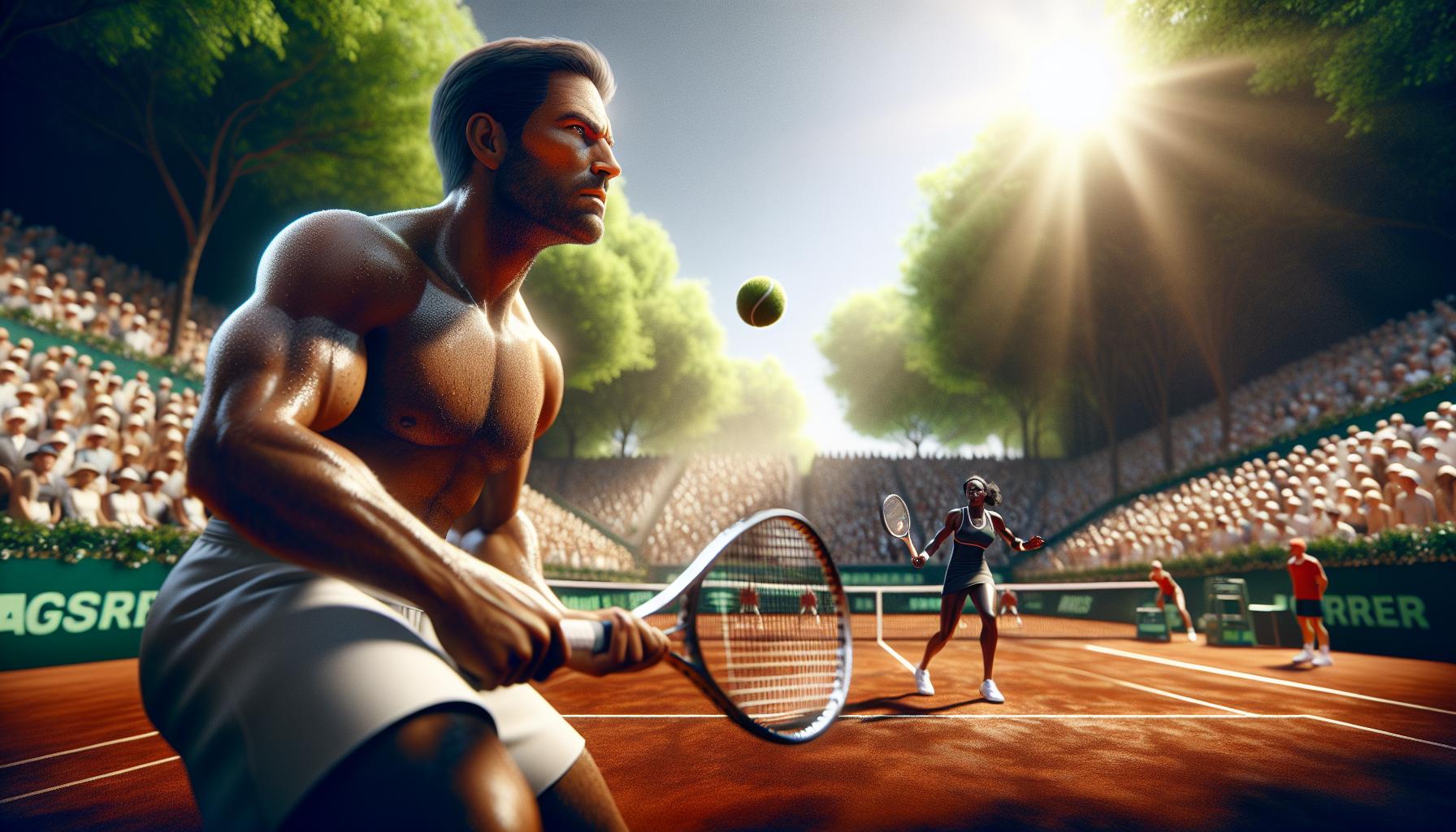Tennis matches captivate fans with their blend of strategy, skill, and endurance. One common question among enthusiasts is: how long are tennis games? The duration can vary widely, influenced by factors like player skill, playing style, and match format.
Understanding the typical length of a tennis game helps fans set expectations and enhances their viewing experience. Whether you’re a casual observer or an aspiring player, knowing what affects game length can deepen your appreciation for the sport’s complexity.
From quick rallies to intense, long-lasting points, each game unfolds uniquely. Additionally, different tournament settings and scoring systems can impact how long a match might last. Dive in to explore the elements that determine the length of tennis games and what you can anticipate when watching your favorite players in action.
Average Length of Tennis Matches
Tennis match durations fluctuate based on match type, tournament level, and playing surface.
By Match Format
- Singles Matches
- Men’s Singles: Average three hours in Grand Slams.
- Women’s Singles: Average two hours in Grand Slams.
- Doubles Matches
- Typically last around one and a half hours.
By Tournament Level
| Tournament Level | Average Match Length |
|---|---|
| Grand Slam | 2 to 3 hours |
| ATP/WTA Tour | 1.5 to 2 hours |
| Challenger Circuits | 1 to 1.5 hours |
By Playing Surface
- Clay Courts: Extend match duration due to slower ball speeds and longer rallies.
- Grass Courts: Reduce match length with faster gameplay and quicker points.
- Hard Courts: Maintain moderate match durations, balancing speed and endurance.
Impact of Scoring Systems
Different scoring formats influence match length:
- Best of Three Sets: Average two hours for singles.
- Best of Five Sets: Average three hours for men’s singles in Grand Slams.
- Tiebreaks: Shorten matches by resolving sets quickly when scores reach 6-6.
Understanding these factors helps predict match lengths and enhances the viewing experience for fans and players alike.
Factors Affecting Match Duration

Several factors influence the length of a tennis match. Understanding these elements helps predict match durations and enhances the viewing experience.
Number of Sets
The number of sets determines the potential length of a match.
- Best of Three Sets: Matches typically last between 1 to 2 hours.
- Best of Five Sets: Matches can extend from 2 to 3 hours or more.
| Match Type | Average Duration |
|---|---|
| Best of Three Sets | 1.5 hours |
| Best of Five Sets | 2.5 hours |
Player Skill Level
Player skill significantly impacts match duration.
- Evenly Matched Players: Games extend longer due to closely contested sets.
- Disparity in Skill: Matches conclude faster as one player dominates.
Highly skilled players often engage in strategic play, leading to extended rallies and prolonged matches.
Differences in Game Formats
Tennis matches vary in duration based on their game formats. Understanding these formats helps predict match lengths and enhances the viewing experience.
Best of Three vs. Best of Five
Best of three sets requires players to win two sets to secure the match. Matches typically last between 1 to 2 hours. This format is standard in women’s tournaments and many men’s competitions outside Grand Slams.
Best of five sets mandates winning three sets to win the match. These matches generally span 2 to 3 hours or more. Best of five formats are primarily used in Grand Slam men’s singles, resulting in longer and more physically demanding games.
Tiebreak Rules
Standard tiebreaks are played when a set reaches six-all. Players compete to reach seven points with at least a two-point advantage. Tiebreaks help limit set lengths, reducing overall match duration.
Variation in tiebreak rules exists across tournaments. For example, Wimbledon employs a tiebreak at 12-all in the final set, while some tournaments avoid tiebreaks, requiring players to win by two games. These variations affect match length by either standardizing or extending set durations.
Impact of Weather and Court Surface
Weather Conditions
Weather significantly influences tennis match durations by affecting player performance and court conditions. High temperatures can increase player fatigue, leading to more frequent breaks and extended match times. Strong winds alter ball trajectories, causing longer rallies and additional points. High humidity levels may slow down the court surface, resulting in extended points and increased match length. Additionally, rain can cause delays or suspensions, prolonging the overall duration of tournaments.
Court Surface Types
Different court surfaces directly impact the speed and length of tennis matches. The primary surfaces include clay, grass, and hard courts, each with unique characteristics:
Clay Courts
- Slower ball speed due to higher friction.
- Longer rallies and extended match durations.
- Average match length: 2.5 to 3.5 hours.
Grass Courts
- Faster ball speed and lower bounce.
- Shorter rallies and quicker match conclusions.
- Average match length: 1.5 to 2.5 hours.
Hard Courts
- Moderate ball speed and bounce.
- Balanced rally lengths and match durations.
- Average match length: 2 to 3 hours.
Statistical Overview
| Court Surface | Ball Speed | Average Match Duration |
|---|---|---|
| Clay | Slow | 2.5 – 3.5 hours |
| Grass | Fast | 1.5 – 2.5 hours |
| Hard | Moderate | 2 – 3 hours |
Interaction Between Weather and Surface
The combination of weather conditions and court surface can further influence match lengths. For example, clay courts become even slower when the weather is humid, increasing match durations. Conversely, grass courts remain fast-paced even in windy conditions, maintaining shorter match times. Understanding these interactions helps predict match lengths more accurately.
Notable Long and Short Matches
Longest Tennis Matches
| Year | Tournament | Players | Duration | Set Score |
|---|---|---|---|---|
| 2010 | Wimbledon | John Isner vs. Nicolas Mahut | 11 hours 5 minutes | 6–4, 3–6, 6–7^(7–9), 7–6^(7–3), 70–68 |
| 2012 | Davis Cup | Leonardo Mayer vs. João Souza | 6 hours 43 minutes | 3–6, 6–3, 6–7^(5–7), 7–6^(7–3), 11–9 |
| 2019 | Indian Wells | Andy Murray vs. John Isner | 6 hours 15 minutes | 7–6^(7–4), 6–7^(3–7), 7–6^(7–5), 6–7^(3–7), 6–4 |
| 2018 | Miami Open | Rafael Nadal vs. John Isner | 6 hours 42 minutes | 7–6^(7–4), 6–7^(3–7), 6–4 |
Shortest Tennis Matches
| Year | Tournament | Players | Duration | Set Score |
|---|---|---|---|---|
| 1989 | Wimbledon | Tom Gullikson vs. Greg Holmes | 20 minutes | 6–0, 6–0 |
| 2018 | US Open | John Isner vs. Steve Johnson | 48 minutes | 6–3, 6–2 |
| 2009 | Australian Open | David Nalbandian vs. Adrian Ungur | 29 minutes | 6–1, 6–1, 6–1 |
| 2017 | Wimbledon | Nick Kyrgios vs. Bernard Tomic | 47 minutes | 6–7^(7–9), 6–4, 6–4 |
- John Isner’s Marathon Matches: Notably, John Isner participated in the longest match in history at Wimbledon 2010 and other extended matches, showcasing exceptional endurance.
- Swift Victories: Matches like Tom Gullikson vs. Greg Holmes at Wimbledon 1989 exemplify some of the quickest decisive victories in professional tennis.
Conclusion
Understanding the length of tennis matches enhances appreciation for the sport’s complexity and the athletes’ endurance. Factors like player skill, playing surface, and tournament level play critical roles in determining match duration. Whether it’s the intense rallies on clay courts or the swift points on grass, each surface offers a unique viewing experience. Awareness of these elements not only enriches spectators’ enjoyment but also provides valuable insights for players aiming to improve their game strategies. As tennis continues to evolve, the dynamics of match lengths will remain a fascinating aspect for fans and participants alike, highlighting the sport’s blend of strategy, skill, and resilience.

